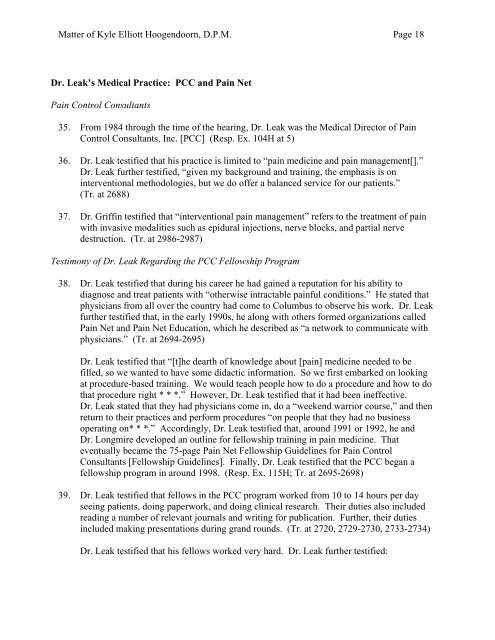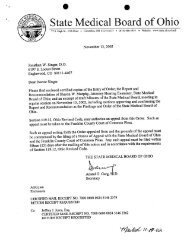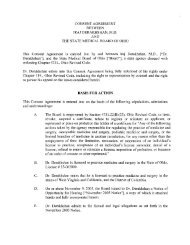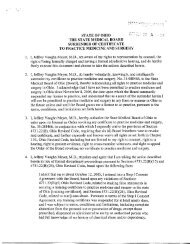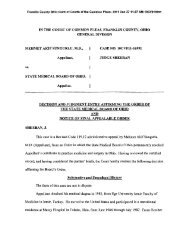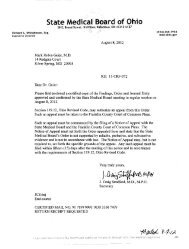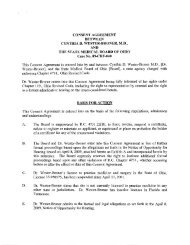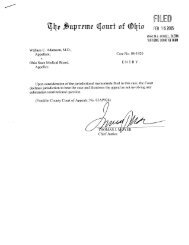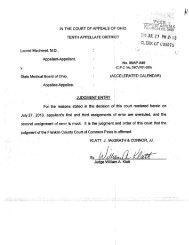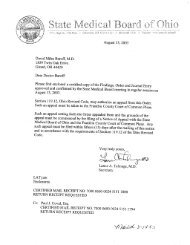CONSENT AGREEMENT BETWEEN - State Medical Board of Ohio ...
CONSENT AGREEMENT BETWEEN - State Medical Board of Ohio ...
CONSENT AGREEMENT BETWEEN - State Medical Board of Ohio ...
You also want an ePaper? Increase the reach of your titles
YUMPU automatically turns print PDFs into web optimized ePapers that Google loves.
Matter <strong>of</strong> Kyle Elliott Hoogendoorn, D.P.M. Page 18<br />
Dr. Leak’s <strong>Medical</strong> Practice: PCC and Pain Net<br />
Pain Control Consultants<br />
35. From 1984 through the time <strong>of</strong> the hearing, Dr. Leak was the <strong>Medical</strong> Director <strong>of</strong> Pain<br />
Control Consultants, Inc. [PCC] (Resp. Ex. 104H at 5)<br />
36. Dr. Leak testified that his practice is limited to “pain medicine and pain management[].”<br />
Dr. Leak further testified, “given my background and training, the emphasis is on<br />
interventional methodologies, but we do <strong>of</strong>fer a balanced service for our patients.”<br />
(Tr. at 2688)<br />
37. Dr. Griffin testified that “interventional pain management” refers to the treatment <strong>of</strong> pain<br />
with invasive modalities such as epidural injections, nerve blocks, and partial nerve<br />
destruction. (Tr. at 2986-2987)<br />
Testimony <strong>of</strong> Dr. Leak Regarding the PCC Fellowship Program<br />
38. Dr. Leak testified that during his career he had gained a reputation for his ability to<br />
diagnose and treat patients with “otherwise intractable painful conditions.” He stated that<br />
physicians from all over the country had come to Columbus to observe his work. Dr. Leak<br />
further testified that, in the early 1990s, he along with others formed organizations called<br />
Pain Net and Pain Net Education, which he described as “a network to communicate with<br />
physicians.” (Tr. at 2694-2695)<br />
Dr. Leak testified that “[t]he dearth <strong>of</strong> knowledge about [pain] medicine needed to be<br />
filled, so we wanted to have some didactic information. So we first embarked on looking<br />
at procedure-based training. We would teach people how to do a procedure and how to do<br />
that procedure right * * *.” However, Dr. Leak testified that it had been ineffective.<br />
Dr. Leak stated that they had physicians come in, do a “weekend warrior course,” and then<br />
return to their practices and perform procedures “on people that they had no business<br />
operating on* * *.” Accordingly, Dr. Leak testified that, around 1991 or 1992, he and<br />
Dr. Longmire developed an outline for fellowship training in pain medicine. That<br />
eventually became the 75-page Pain Net Fellowship Guidelines for Pain Control<br />
Consultants [Fellowship Guidelines]. Finally, Dr. Leak testified that the PCC began a<br />
fellowship program in around 1998. (Resp. Ex. 115H; Tr. at 2695-2698)<br />
39. Dr. Leak testified that fellows in the PCC program worked from 10 to 14 hours per day<br />
seeing patients, doing paperwork, and doing clinical research. Their duties also included<br />
reading a number <strong>of</strong> relevant journals and writing for publication. Further, their duties<br />
included making presentations during grand rounds. (Tr. at 2720, 2729-2730, 2733-2734)<br />
Dr. Leak testified that his fellows worked very hard. Dr. Leak further testified:


